|
/1975-88-172reduce3.jpg) |
|
|
New Brunswick Museum, Saint John, N.B., 1975.88.172
Alice Lusk Webster
by John White
Alexander, 1904-5
oil on canvas, 93.2 x
53.8 cm |
|
"The
civilization of a people
finds
expression in its art."
Alice Lusk Webster
(1880-1953)
In the 1940s, Alice Lusk Webster explained her theory of art while
guiding visitors through the Department of Arts and Crafts she had founded
at the New Brunswick Museum in Saint John, New Brunswick. She proudly
displayed her collection of international objects, including Chinese,
Japanese and Egyptian ceramics, in carefully arranged
glass cases.
"The civilization of a people finds expression in its art," she asserted,
"and its art is the mirror in which each stage of its development is
reflected."
As Honourary Curator of the Department, Lusk Webster
stressed that beauty was not confined to the
so-called fine arts, but could also have a functional basis. Her collections
included such everyday artefacts as hair pins, jewelry and fish
hooks, many stemming from ancient times. According to her, these items could
"demonstrate the continuity of man's
effort to please himself in fashioning tools, utensils, and fabrics for his
own use." Lusk Webster's goal was to
provide a representative collection of fine art and craft for what she
affectionately called the "backwoods" of New Brunswick. She hoped to
encourage both a broader historical knowledge of artistic form and a more
cultivated level of taste in the province.
Lusk Webster and her husband,
Dr. J. Clarence Webster,
were involved in the New Brunswick Museum by the 1930s, when benevolent
patrons were needed in the absence of government funding. The New
Brunswick Museum was created as a provincial institution in 1929 (and it
officially opened in 1934), amalgamating the collections of the Gesner
Museum (1842-46), the Mechanics' Institute Museum (1846-90), and the
Natural History Society
of New Brunswick (1862-1932), all founded in Saint John.
Although members of the Natural History Society remained involved in the new
institution, they were ultimately displaced by wealthy patrons such as the
Websters. J. Clarence Webster served as both a board member and Honourary
Curator of Canadian History until his death in 1950, while Lusk Webster
founded the Department of Arts and Crafts in 1934, and was its Honourary
Curator until her death in 1953. To this day, the Foundation established by
the Websters continues to provide funds for the New Brunswick Museum.
Alice Lusk Webster was born in New York City in 1880, the daughter of
Bellevue Hospital's Chief of Obstetrics, Dr. William Thompson Lusk, and Mathilda (Meyer) Lusk. After receiving her early education in New York,
Alice attended schools in France and Germany. In 1899 she married Dr.
J. Clarence Webster, then a graduate of Edinburgh University and Fellow of
the Royal College of Physicians of Edinburgh. For the next 20 years, Dr. and
Mrs. Webster lived in Chicago where J. Clarence was the Chair of Obstetrics
and Gynecology at Rush Medical College. The couple had three children: John
Clarence Webster Jr., a pilot who died in an air crash in 1931; Janet
Webster Roche, who moved to France after marrying a French artist, and died
after she was arrested by the Nazis during the Second World War; and William
Lusk Webster, a celebrated scientist who worked on the Manhattan Project,
and died in 1975.
While in Chicago, the Websters managed to amass a
world-renowned collection of Japanese and Chinese art. They were well
connected with the world of art patrons and collectors, and even had their
Asian collections exhibited
|
|
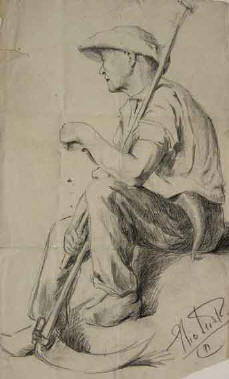 |
|
|
New Brunswick Museum, Saint John, N.B., 1974.143.142
Drawing: "Study of a Seated Man with a Scythe"
signed Alice Lusk, 1897
conté crayon on laid paper
Dr. William Lusk Webster Bequest
|
alongside those of architect Frank Lloyd Wright in 1904.
The Websters' art patronage shifted direction in 1919 when the declining
health of J. Clarence prompted the couple to move to Shediac, New Brunswick,
his birthplace. When Lusk Webster became involved in the New Brunswick
Museum, she found
creative ways to build up its
holdings, sometimes by drawing on the value of her Asian collections.
In 1934, for example, she offered her friend C. T.
Currelly, director of the Royal Ontario Museum of Archaeology, seventeen
fine Japanese paintings owned by her and her husband, in exchange for a
substantial amount of Chinese art and porcelain, which she gave as a
gift-in-kind to the New Brunswick Museum. She also approached her
wealthy friends and family in New York, scavenging cast-off items such as
broken porcelain, which she carefully reassembled and put on display in the
Department of Arts and Crafts. Alice Lusk Webster was clearly an
enterprising and tenacious woman. In 1940, while visiting
London, England, she "secured a donation of British-Roman and early English
material from the Guildhall Museum, persuaded the Dean of Westminster to
part with a thirteenth-century fragment of the Abbey, and obtained a Tudor
Rose from contractors repairing the Houses of Parliament." This ambitious Honourary Curator changed the face of the New Brunswick Museum, moving its
collections beyond provincial and national concerns to include an extensive
representation of international art.
The diverse items collected by Lusk Webster were not only
put on display in the New Brunswick Museum, but also formed part of the
school loan
collection that she created and personally transported to
high schools in Moncton during the late 1930s. She hoped to
invigorate ancient history lessons while providing cultivation to those "men
and women, boys and girls, who are groping blindly for the finer things in
life." Lusk Webster held that an immediate experience of Egyptian, Syrian,
and Roman objects, including a sample of wheat grown 5000 years ago,
scarabs, beads, cuniform tablets, fish hooks, and needles, would accomplish
this end.
The unpaid work that Lusk Webster performed for the New Brunswick Museum was
in keeping with both her gender and her elevated social status. Her wealth
allowed her to be more outspoken in administrative meetings than the women
of the Ladies'
Auxiliary had been, and to amass a valuable collection that
would shape the future of the Museum. Yet during her lifetime, and arguably
even more recently, her work was considered secondary to the chief goals of the
Museum, and linked with the "merely" decorative. In her notebooks, Alice
noted how hard she worked for the Museum, even cleaning and arranging the
collections, while receiving little recognition from male board members. All
the same, when she died in 1953, an obituary published in the
Evening Times-Globe claimed
her passing was a "distinct loss to the cultural
life of New Brunswick," as she had made a "significant
contribution to this province's historical
heritage."
|
|
From Her
Collection
~~~~ |
|
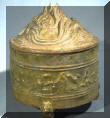
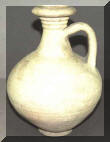
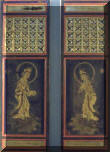

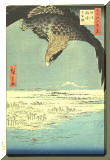

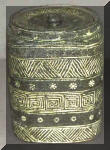

|
|
Sources
 |
Archives of the New Brunswick Museum, Art
Department Records, F544, Alice Lusk Webster's Working Files, Letters,
undated. |
 |
Archives of the New Brunswick Museum, Art
Department Records, F545, Alice Lusk Webster's Working Files, Lecture
Notes, undated. |
 |
Evening Times-Globe.
Saint John. 15 December 1953. |
 |
Royal Ontario Museum, Records
of the Registration Department, undated. |
 |
Times-Globe.
Saint John. 17 October 1940. |
|
|
|
|
![]()